
Bove KE, Thrasher AD, Anders R, Chung CT, Cummings OW, Finegold MJ, Finn L, Ranganathan S, Kim GE, Lovell M, Magid MS, Melin-Aldana H, Russo P, Shehata B, Wang L, White F, Chen Z, Spino C, Magee JC. Inflammation, Active Fibroplasia, and End-stage Fibrosis in 172 Biliary Atresia Remnants Correlate Poorly With Age at Kasai Portoenterostomy, Visceral Heterotaxy, and Outcome. Am J Surg Pathol. 2018 Sep 21. doi: 10.1097/PAS.0000000000001146.
ABSTRACT
Published histologic studies of the hilar plate or entire biliary remnant at the time of Kasai portoenterostomy (KHPE) have not provided deep insight into the pathogenesis of biliary atresia, relation to age at surgery, prognosis or the basis for successful drainage. We report detailed histologic findings in 172 centrally reviewed biliary remnants with an average of 6 sections per subject. Active lesions were classified as either necroinflammatory (rare/clustered in a few subjects) or active concentric fibroplasia with or without inflammation (common). Inactive lesions showed bland replacement by collagen and fibrous cords with little or no inflammation. Heterogeneity was common within a given remnant; however, relatively homogenous histologic patterns, defined as 3 or more inactive or active levels in the hepatic ducts levels, characterized most remnants. Homogeneity did not correlate with age at KHPE, presence/absence of congenital anomalies at laparotomy indicative of heterotaxy and outcome. Remnants from youngest subjects were more likely than older subjects to be homogenously inactive suggesting significantly earlier onset in the youngest subset. Conversely remnants from the oldest subjects were often homogenously active suggesting later onset or slower progression. More data are needed in remnants from subjects <30 days old at KHPE and in those with visceral anomalies. Prevalence of partially preserved epithelium in active fibroplastic biliary atresia lesions at all ages suggests that epithelial regression or injury may not be a primary event or that reepithelialization is already underway at the time of KHPE. We hypothesize that outcome after KHPE results from competition between active fibroplasia and reepithelialization of retained, collapsed but not obliterated lumens. The driver of active fibroplasia is unknown.
For full text, please click here.








